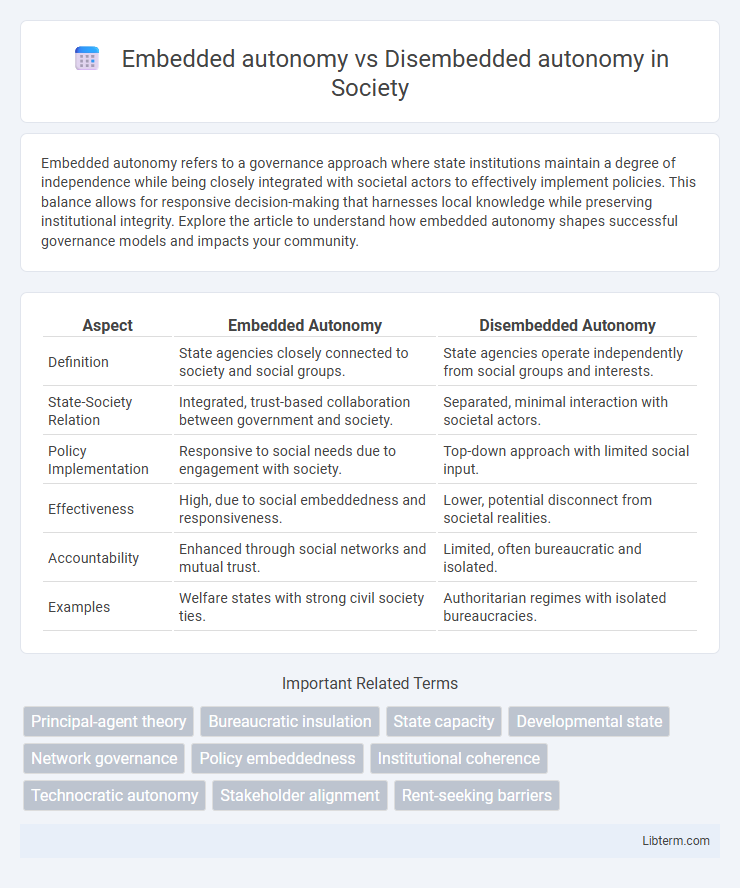Embedded autonomy refers to a governance approach where state institutions maintain a degree of independence while being closely integrated with societal actors to effectively implement policies. This balance allows for responsive decision-making that harnesses local knowledge while preserving institutional integrity. Explore the article to understand how embedded autonomy shapes successful governance models and impacts your community.
Table of Comparison
| Aspect | Embedded Autonomy | Disembedded Autonomy |
|---|---|---|
| Definition | State agencies closely connected to society and social groups. | State agencies operate independently from social groups and interests. |
| State-Society Relation | Integrated, trust-based collaboration between government and society. | Separated, minimal interaction with societal actors. |
| Policy Implementation | Responsive to social needs due to engagement with society. | Top-down approach with limited social input. |
| Effectiveness | High, due to social embeddedness and responsiveness. | Lower, potential disconnect from societal realities. |
| Accountability | Enhanced through social networks and mutual trust. | Limited, often bureaucratic and isolated. |
| Examples | Welfare states with strong civil society ties. | Authoritarian regimes with isolated bureaucracies. |
Understanding Autonomy: Embedded vs Disembedded
Embedded autonomy refers to the capacity of state institutions to implement policies effectively while maintaining strong, cooperative ties with societal actors, enabling mutual trust and information flow crucial for developmental success. Disembedded autonomy, in contrast, describes state institutions operating independently from societal influences, prioritizing bureaucratic impartiality and insulation from interest groups to avoid capture but risking disconnect from local needs and insights. Understanding these concepts highlights the balance between state responsiveness and independence necessary for sustainable governance and economic development.
Defining Embedded Autonomy
Embedded autonomy refers to a governance model where state institutions maintain strong ties with societal groups, enabling effective policy implementation through mutual trust and collaboration. This concept emphasizes the state's capacity to be autonomous in decision-making while remaining embedded within social networks, allowing it to balance control and responsiveness. Embedded autonomy enhances developmental outcomes by facilitating coherent policies supported by both bureaucratic expertise and societal engagement.
Disembedded Autonomy Explained
Disembedded autonomy refers to the capacity of individuals or groups to act independently from traditional social or institutional constraints, often facilitated by digital technologies and global networks. This form of autonomy emphasizes self-governance and decision-making outside established hierarchical or cultural frameworks, enabling more fluid and flexible interactions across diverse contexts. Disembedded autonomy challenges conventional notions of embedded social ties by prioritizing personal agency and decentralized control in dynamic, interconnected environments.
Historical Context of Autonomy in Governance
Embedded autonomy in governance refers to the state's capacity to implement policies effectively while maintaining strong relationships with societal actors, a concept developed from Peter Evans' analysis of East Asian developmental states in the late 20th century. Disembedded autonomy contrasts this by emphasizing a state's independence from social interests, often linked historically to liberal Western democracies where institutional separation minimizes social influence to prevent clientelism and corruption. The historical context reveals how developmental trajectories and socio-political structures shaped different models of state autonomy, influencing governance strategies and state-society interactions globally.
Key Differences Between Embedded and Disembedded Autonomy
Embedded autonomy refers to a state where government agencies maintain close ties with social and economic actors, enabling coordinated policy implementation while preserving relative independence. Disembedded autonomy occurs when government agencies operate independently from societal influences, emphasizing bureaucratic neutrality and insulation from external pressures. Key differences include the degree of interaction with social groups, the balance between autonomy and embeddedness, and the impact on policy responsiveness and coherence.
Impacts on Policy Implementation
Embedded autonomy enhances policy implementation by fostering strong ties between state agencies and societal actors, ensuring policies are both informed by local knowledge and aligned with national goals. Disembedded autonomy, characterized by a more insulated state bureaucracy, can lead to efficient decision-making processes but risks disconnecting policies from the socio-economic realities on the ground. The balance between embedded and disembedded autonomy influences the adaptability, legitimacy, and effectiveness of policy execution across different governance contexts.
Case Studies: Successes and Failures
Embedded autonomy, where the state maintains close ties with societal groups while retaining bureaucratic capacity, often leads to successes such as South Korea's rapid industrialization, exemplified by coordinated policy-making and effective collaboration between government and business. In contrast, disembedded autonomy, characterized by a state operating separately from social interests, can result in failures like Argentina's economic crises, where lack of social embeddedness led to policy isolation and decreased legitimacy. Case studies demonstrate that embedded autonomy balances state control with social input, fostering sustainable development, whereas disembedded autonomy risks detachment and ineffectiveness.
Challenges in Maintaining Effective Autonomy
Maintaining effective autonomy in embedded autonomy faces challenges such as balancing close interaction with societal or organizational stakeholders while preserving decision-making independence, often leading to conflicts of interest and pressures to conform. Disembedded autonomy struggles with isolation from contextual inputs, which can result in detached policies lacking practical relevance and reduced adaptability to local conditions. Both models demand careful calibration of transparency, accountability, and responsiveness to sustain operational effectiveness without compromising autonomy.
The Role of Social Networks and Institutions
Embedded autonomy emphasizes the integration of state actors within dense social networks and institutions, enabling effective coordination and trust-building essential for policy implementation. Disembedded autonomy relies on state actors operating independently from social ties, often resulting in centralized decision-making with less input from institutional stakeholders. The role of social networks and institutions in embedded autonomy fosters cooperation and resource mobilization, strengthening governance and development outcomes.
Future Directions for Autonomy in Modern States
Future directions for embedded autonomy emphasize strengthening state capacity by fostering close cooperation between bureaucratic institutions and local social actors, thereby enhancing policy implementation and social accountability. In contrast, disembedded autonomy prioritizes increasing state independence from societal influences, leveraging advanced technologies and data-driven governance to streamline decision-making and reduce political interference. Balancing embedded and disembedded autonomy through hybrid governance models could optimize state responsiveness and effectiveness in addressing complex challenges in modern societies.
Embedded autonomy Infographic

 libterm.com
libterm.com